Tire Size 265/75r16 vs 235/85r16
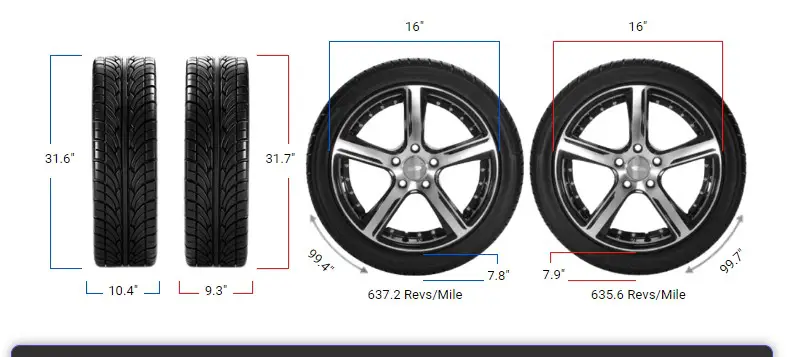
Tire sizing can be confusing, but understanding the implications of switching from 265/75r16 to 235/85r16 tires is crucial for vehicle performance and safety. Let’s explore the key differences and their effects on both on-road and off-road driving.
- Tire diameter remains nearly identical, with only a 0.2% increase.
- Width decreases significantly by 11.3%, from 10.43 inches to 9.25 inches.
- Sidewall height increases slightly by 0.5%, from 7.82 inches to 7.86 inches.
- Speedometer accuracy is minimally affected, with a 0.2% difference at 20 mph.
265/75r16 vs 235/85r16
The most significant change when switching from 265/75r16 to 235/85r16 tires is the width reduction. The new tires are 1.18 inches (30 mm) narrower, which can affect handling, traction, and overall vehicle appearance.
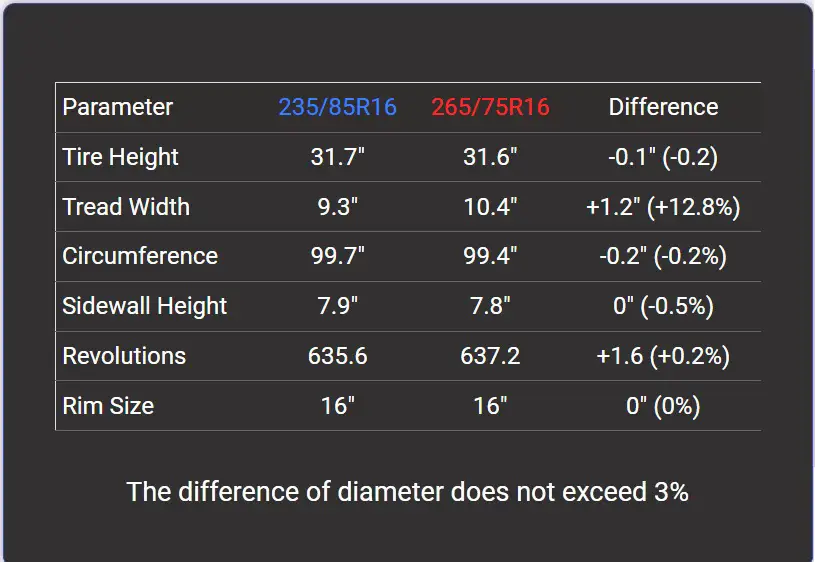
Fitment Guide
The fitment guide indicates that the diameter difference between the 265/75r16 and 235/85r16 tires is well within the acceptable range of plus or minus 3%.
With only a 0.2% difference in diameter, this tire switch is generally considered safe and shouldn’t require any major vehicle modifications.
On-Road Impact
Switching to 235/85r16 tires can have several effects on your vehicle’s on-road performance. Let’s examine how this change might impact your daily driving experience.
- Handling: The narrower width of the 235/85r16 tires may result in slightly reduced cornering grip on dry pavement. This could make the vehicle feel less stable during quick turns or lane changes. However, the difference is relatively small and may not be noticeable to most drivers in everyday situations.
- Ride Comfort: The taller sidewall of the 235/85r16 tires (7.86 inches vs. 7.82 inches) might provide a marginally smoother ride over bumps and rough roads. This is because there’s slightly more rubber to absorb road imperfections. However, the 0.5% difference is minimal, so the improvement in ride quality may be negligible.
- Gas Mileage: The narrower profile of the 235/85r16 tires could potentially improve fuel efficiency by reducing rolling resistance. However, the impact is likely to be small, perhaps only noticeable over long distances or extended periods.
- Aesthetics: The switch to narrower tires will change your vehicle’s appearance. The wheel wells may appear larger, which some drivers might find less visually appealing. Others might prefer the more rugged look of a narrower tire with a taller sidewall.
- Speedometer Accuracy: The data shows that at 20 mph, the actual speed with the new tires would be 20.05 mph. This 0.2% difference is negligible in practical terms. Your speedometer will remain accurate enough for everyday use without requiring recalibration.
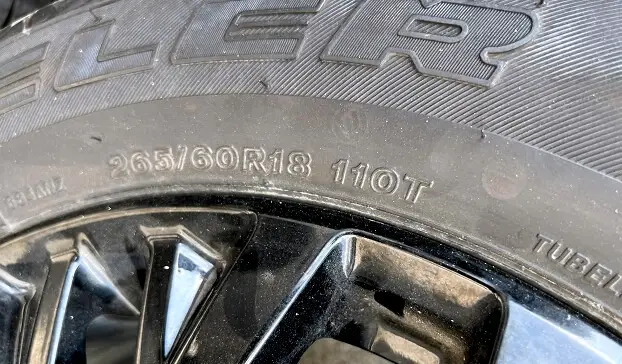
Off-Road Impact
For those who enjoy off-road adventures, the switch to 235/85r16 tires can have some interesting effects. Here’s how your off-road experience might change with the new tire size.
- Traction: The narrower width of the 235/85r16 tires can actually be beneficial in certain off-road conditions. In mud or snow, narrower tires can “cut” through the surface more easily, potentially improving traction. However, in sandy conditions, wider tires are generally preferred for their ability to “float” on top of the surface.
- Ground Clearance: The slight increase in overall diameter (0.08 inches or 2 mm) will provide a minimal boost in ground clearance. While every bit helps when off-roading, this small difference is unlikely to have a significant impact on your vehicle’s ability to clear obstacles.
- Maneuverability: The narrower tires might make your vehicle slightly more agile on tight trails. With less rubber contacting the ground, steering effort could be reduced, making it easier to navigate through challenging terrain.
- Sidewall Strength: The taller sidewall of the 235/85r16 tires (7.86 inches vs. 7.82 inches) provides a tiny bit more protection against rocks and debris. This might slightly reduce the risk of sidewall damage when driving over rough terrain, but the difference is minimal.
- Flotation: In soft conditions like sand or deep mud, the narrower 235/85r16 tires may sink more easily than the wider 265/75r16 tires. This could potentially make it harder to maintain momentum in these situations.
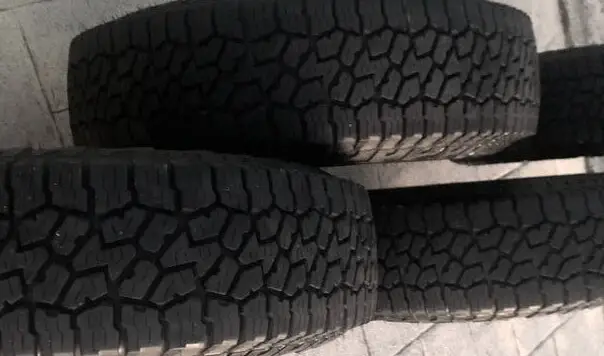
What is the Difference Between 265/75r16 and 235/85r16?
The main difference between 265/75r16 and 235/85r16 tires is their width. The 265/75r16 tire is significantly wider at 10.43 inches (265 mm), while the 235/85r16 tire is narrower at 9.25 inches (235 mm).
This represents a width reduction of 1.18 inches (30 mm) or 11.3%. This substantial change in width can affect various aspects of vehicle performance, including handling, traction, and overall appearance.
The narrower tire may provide different driving characteristics, particularly in cornering and stability, and could alter the vehicle’s look by making the wheel wells appear larger.
Can I Use 235/85r16 Instead of 265/75r16?
Yes, you can use 235/85r16 tires instead of 265/75r16 tires. The diameter difference between these two tire sizes is only 0.2%, which is well within the recommended 3% tolerance.
This minimal difference in diameter means that the switch shouldn’t cause any significant issues with vehicle systems or require any major modifications.
However, keep in mind that the substantial difference in width (11.3% narrower) may affect handling characteristics and appearance.
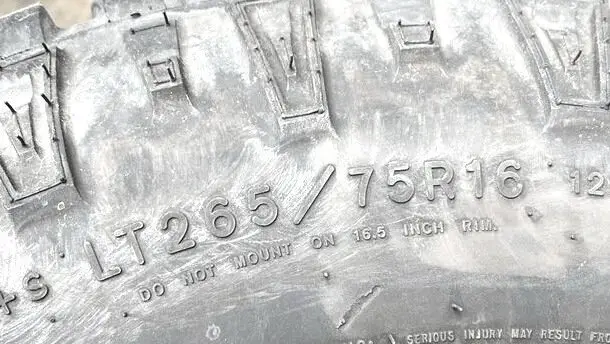
How Much Taller Is A 235/85r16 Tire Than A 265/75r16?
A 235/85r16 tire is slightly taller than a 265/75r16 tire, but the difference is minimal. The 235/85r16 tire has a diameter of 31.73 inches (805.9 mm), while the 265/75r16 tire has a diameter of 31.65 inches (803.9 mm).
This means the 235/85r16 tire is 0.08 inches (2 mm) taller, which is a 0.2% increase in height. This difference is negligible and unlikely to have any noticeable impact on vehicle performance or clearance.
How Much Wider is a 235/85r16 Tire Than a 265/75r16?
Actually, the 235/85r16 tire is narrower than the 265/75r16 tire, not wider. The 265/75r16 tire has a width of 10.43 inches (265 mm), while the 235/85r16 tire has a width of 9.25 inches (235 mm).
This means the 235/85r16 tire is 1.18 inches (30 mm) narrower than the 265/75r16 tire, representing an 11.3% reduction in width. This significant difference in width is the most notable change when switching between these two tire sizes.
Our Observation
Switching from 265/75r16 to 235/85r16 tires offers a mix of benefits and drawbacks. The narrower width may improve fuel efficiency and provide better traction in some off-road conditions, particularly in mud and snow.
However, it could slightly reduce dry pavement grip and sand performance. The minimal change in diameter ensures that speedometer accuracy and ground clearance remain virtually unchanged.
For most drivers, the differences in on-road performance will be subtle, if noticeable at all. Off-road enthusiasts might appreciate the potential for improved maneuverability on tight trails, but may need to adjust their driving style in certain terrains.
Overall, this tire switch is feasible and safe, with its impacts being more noticeable in specific driving scenarios rather than in everyday use.

Meet Caitlin McCormack, a Tire Size Expert and Blogger Passionate About Everything Related to Tires. With Years of Experience in the Tire Industry, Caitlin Has Become an Expert in Tire Sizes and Their Impact on Vehicle Performance.
